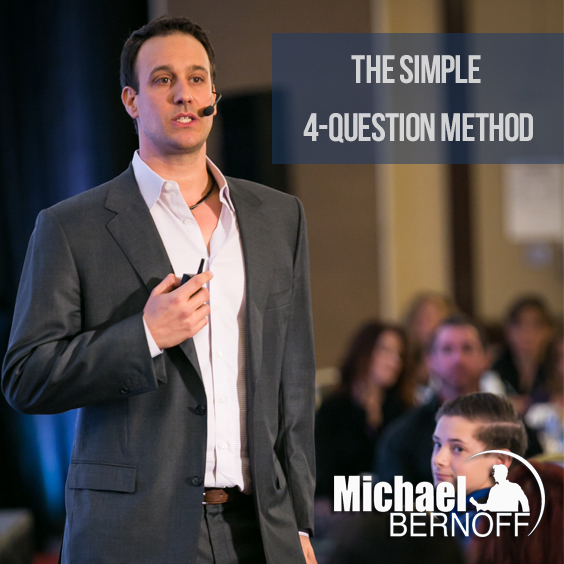
21 Jun Knock Out Frustrations with the 4-Question Method
Are you ready to overcome frustration and achieve happiness? By asking yourself just four questions, I believe you can start doing what you want to do, living the life you want to live and letting go of the things that aren’t working for you.
But before I reveal the questions, I want you to grab a piece of paper. Divide the page into four columns. In the far left column, write “strength.” Now, think of something you’re good at. It could be anything: organizing, appearing confident, multitasking, etc. Write it down. In the next column, write “weakness.” We all have them and they don’t make us weak people. They’re simply things that we’re not so good at. So, go ahead and
write one down.[/vc_column_text]
I hear people share so many frustrations and a lot of the
same ones come up again and again: It’s just not happening quick enough. I’m not sure I’m getting there fast enough. It’s not happening the way I’d like it to happen. This isn’t working. How do I know I’m getting there? I can’t get people to move the way I need them to move.
My strength is public speaking and coaching. The thing I’m not as good at is organizing.
I’m good at talking through the organization part of a project, but physically working on it
is just not my thing. So, I’ll use those examples for this exercise.
The next step is to write “frustration” in the next column. I know we all have many frustrations, so this part should come easy, but for now pick one big one. During my telecoaching program, Call 2 Action, I hear people share so many frustrations and a lot of the
same ones come up again and again:
“It’s just not happening quick enough.”
“I’m not sure I’m getting there fast enough.”
“It’s not happening the way I’d like it to happen.”
“This isn’t working.” “
“How do I know I’m getting there?”
“I can’t get people to move the way I need them to move.”

Any of these will work, as well as others that you may have going on. Finally, in the last column, write “solutions” and this is key—at the heart of what we’re going to accomplish
today.
How many of you would love it if you could just go to the strength column to find solutions to your problems? It would be so great (and easy) if our strengths solved everything. Great at baseball? Bring your bat to class our your next sales call. Have a knack for inspiring others? Why not inspire yourself to follow through on a business plan? So often, we look to our strengths to solve our problems. It’s a hard pill to swallow, but a lot of times this simply doesn’t work.
I may be really good at quick thinking and communicating, but I can’t talk myself into a solution. I also can’t talk myself into an organized desk. You can’t talk yourself into a business plan or making your clients move faster. Your strength has a place and that’s why I had you to write down, but what’s really, really, weird is that if you do this exercise, you’ll begin to realize that your strength is probably causing the majority of your frustration.
Here’s another example. How many of you ever feel you do something so well yourself that if you delegate, it’s not going to get done as well? Call it impatient. Call it a lack of good candidates to hand projects off to. Call it whatever you want. You’re good at it, so you’re not good at handing it to anybody. I have this same battle. In this case, your strength just became your weakness. So, how do we break this cycle?
I tell every one of my clients the same thing: the only way to change the situation is to change yourself. But it’s easy and normal to get frustrated. So, look at the sheet of paper in front of you and begin to accept that your strengths will not solve all of your frustrations and may actually be adding to them.
So, now back to “solutions.” Our first reaction is to tell ourselves “just do it” like the Nike ad. In other words, we should “just get out there and push harder.” With this line of thinking, however, we’re probably destined to continue the frustration. By the same token, continuing to talk about a problem is not going to create a solution, either.
Here’s a great example from one of my clients who is so influential at sales and communication that when a problem arises, she convinces herself her frustration isn’t there. This may last for one week before she becomes frustrated again with the same problem that was never actually solved in the first place. You may find yourself repeating a similar cycle—attempting to inspire yourself or creating a business plan to eliminate frustration. These tactics rarely work. So, here’s the four simple and effective questions which will help you overcome frustration and get you on your way to solutions.
1. What do you want to be doing that you’re not doing right now?
Much different and ultimately better than “what’s wrong,” this one helps identify what’s really frustrating you. Hint: it may not be what you think. Maybe you’ll discover that what you really want is to not be bothered by your frustrations. Maybe, you’d like to have a little more consistency and organization in your life. Great. Then, take it a step further and begin to think about what areas of your life you’d like to develop? And what obstacles could show up that could stop you?
2. What would you like to see happen right now?
This one forces you to really focus on what needs to be put into motion for change to happen. It demands you be specific about your goals and desires. Answering this question gives you a clear vision of what you really want to see occur in your life.
3. How do I hold you accountable?
Rather than having someone ask you “how can I help” or “what can I do for you” this one puts you in the position to identify steps YOU need to take. And by saying them out loud, you accept accountability and are much more likely to follow through. Understand, the power in this question lies within the personal accountability. Only YOU can take the steps necessary to become more patient, develop your weaknesses, build new strengths, etc. No one can do it for you. Come up with a strategy of what it would take for you to be accountable to being the person you want to be.
4. What skills do you need to pull that off?
So you know what you need to do, but haven’t done them yet! Why not? Now is where we begin to focus on strengths and weaknesses again. Are there strengths you can tap into to accomplish these tasks? Do you have weaknesses that could be developed into strengths that would help get things done? Or are there entirely new skills that require exploration? This is a much different plan—something we don’t wake up and think about on a regular basis.
Don’t be surprised if you discover you’ve been running after your strengths because you’re good at them while running away from your weaknesses because you’re bad at them.
You’re frustrated because you’re not doing what you really want to be doing. Focusing on the wrong things inevitably leads to frustration. The four questions I put before you are designed to help you coach yourself—rather than waiting for action or advice from other people. It’s just a small part of what I teach through Call 2 Action and my other programs and it has helped thousands of people change their lives and get past their frustrations in business, relationships and other areas of life.
The key to success is living the life you want to live. Why not start now? Any of these will work, as well as others that you may have going on. Finally, in the last column, write “solutions” and this is key—at the heart of what we’re going to accomplish today.
How many of you would love it if you could just go to the strength column to find solutions to your problems? It would be so great (and easy) if our strengths solved everything. Great at baseball? Bring your bat to class our your next sales call. Have a knack for inspiring others? Why not inspire yourself to follow through on a business plan? So often, we look to our strengths to solve our problems. It’s a hard pill to swallow, but a lot of times this simply doesn’t work.
I may be really good at quick thinking and communicating, but I can’t talk myself into a solution. I also can’t talk myself into an organized desk. You can’t talk yourself into a business plan or making your clients move faster. Your strength has a place and that’s why I had you to write down, but what’s really, really, weird is that if you do this exercise, you’ll begin to realize that your strength is probably causing the majority of your frustration.
Here’s another example. How many of you ever feel you do something so well yourself
that if you delegate, it’s not going to get done as well? Call it impatient. Call it a lack of
good candidates to hand projects off to. Call it whatever you want. You’re good at it, so
you’re not good at handing it to anybody. I have this same battle. In this case, your
strength just became your weakness. So, how do we break this cycle?
I tell every one of my clients the same thing: the only way to change the situation is to
change yourself. But it’s easy and normal to get frustrated. So, look at the sheet of paper
in front of you and begin to accept that your strengths will not solve all of your
frustrations and may actually be adding to them.
So, now back to “solutions.” Our first reaction is to tell ourselves “just do it” like the
Nike ad. In other words, we should “just get out there and push harder.” With this line of
thinking, however, we’re probably destined to continue the frustration. By the same
token, continuing to talk about a problem is not going to create a solution, either.
Here’s a great example from one of my clients who is so influential at sales and
communication that when a problem arises, she convinces herself her frustration isn’t
there. This may last for one week before she becomes frustrated again with the same
problem that was never actually solved in the first place. You may find yourself repeating
a similar cycle—attempting to inspire yourself or creating a business plan to eliminate
frustration. These tactics rarely work. So, here’s the four simple and effective questions
which will help you overcome frustration and get you on your way to solutions.
1. What do you want to be doing that you’re not doing right now?
Much different and ultimately better than “what’s wrong,” this one helps identify what’s
really frustrating you. Hint: it may not be what you think. Maybe you’ll discover that
what you really want is to not be bothered by your frustrations. Maybe, you’d like to have
a little more consistency and organization in your life. Great. Then, take it a step further
and begin to think about what areas of your life you’d like to develop? And what
obstacles could show up that could stop you?
2. What would you like to see happen right now?
This one forces you to really focus on what needs to be put into motion for change to
happen. It demands you be specific about your goals and desires. Answering this
question gives you a clear vision of what you really want to see occur in your life.
3. How do I hold you accountable?
Rather than having someone ask you “how can I help” or “what can I do for you” this one
puts you in the position to identify steps YOU need to take. And by saying them out loud,
you accept accountability and are much more likely to follow through. Understand, the
power in this question lies within the personal accountability. Only YOU can take the
steps necessary to become more patient, develop your weaknesses, build new strengths,
etc. No one can do it for you. Come up with a strategy of what it would take for you to
be accountable to being the person you want to be.
4. What skills do you need to pull that off?
So you know what you need to do, but haven’t done them yet! Why not? Now is where
we begin to focus on strengths and weaknesses again. Are there strengths you can tap
into to accomplish these tasks? Do you have weaknesses that could be developed into
strengths that would help get things done? Or are there entirely new skills that require
exploration? This is a much different plan—something we don’t wake up and think about
on a regular basis.
Don’t be surprised if you discover you’ve been running after your strengths because
you’re good at them while running away from your weaknesses because you’re bad at
them.
You’re frustrated because you’re not doing what you really want to be doing. Focusing on
the wrong things inevitably leads to frustration. The four questions I put before you are
designed to help you coach yourself—rather than waiting for action or advice from other
people. It’s just a small part of what I teach through Call 2 Action and my other
programs and it has helped thousands of people change their lives and get past their
frustrations in business, relationships and other areas of life.
The key to success is living the life you want to live. Why not start now?

